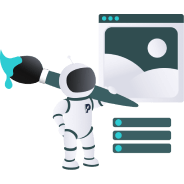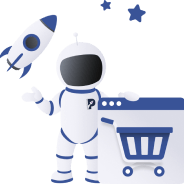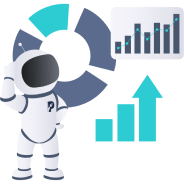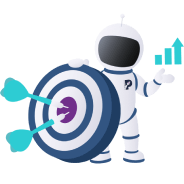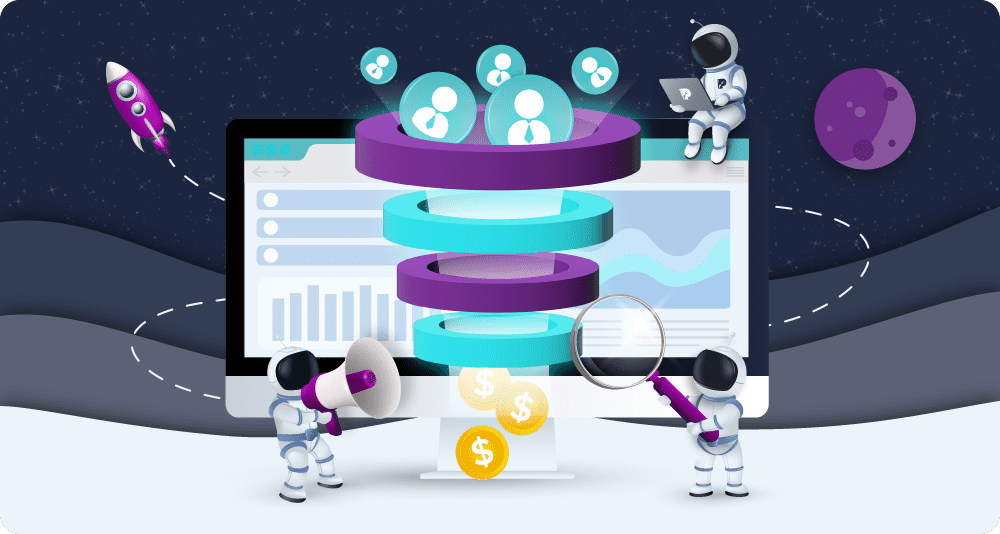

Is There a Difference Between Marketing Funnels and Sales Funnels?
Lead generation is one of the most important aspects of running a business, and funnels can be a huge help. But should you be using a marketing funnel or a sales funnel? And are they even that different from each other?
Though marketing and sales are closely linked, the fact remains that they are separate practices, and their respective techniques, although sometimes overlapping, will vary. Furthermore, they won’t always share the same goals.
Both marketing and sales make use of funnels, which can be extremely helpful for organising marketing efforts, understanding customer journeys, and optimising B2C interactions.
In general, business owners tend to go for either sales funnels or marketing funnels – hardly ever knowing about the other or mistakenly seeing them as the same thing.
Though the differences between these two funnels are small, knowing them can be helpful for businesses when it comes to defining what they want to gain from funnels and how they’ll use them. Down the line, this can further help resource and task distribution as well as clarify performance metrics departmentally and at the different funnel stages.
This article will explain the differences between these two funnels and explore how you can best use them to your company’s advantage.
What is a sales funnel?
Sales funnels are the path a customer takes from first hearing about your service or product to purchasing that service or product. The funnel follows three stages the customer goes through: the initial interest phase, the consideration phase, and the highly interested or purchasing phase.
Businesses can use sales funnels to better understand their customers and nurture their journey from being initially interested to deciding to make a purchase. For example, you’ll likely discover the average length of time it takes for a lead to remain in the consideration phase, which can help with planning and tracking the efficacy of your efforts. Furthermore, looking closely at each phase can indicate which parts of your marketing require refining.
Strong sales funnels also allow businesses to get their products or services to reach the people most in need of them – otherwise called high-quality traffic. Other benefits include gaining more customer information via mailing list sign-ups and automated lead generation processes that allow business owners, managers, and staff members alike to focus on other important tasks.
The sales funnel stages are sometimes known as ToFu, MoFu, and BoFu. Here’s what they mean:
ToFu: Leads at the top of the funnel are interested in what you’re offering but haven’t yet made a commitment.
MoFu: In the middle of the sales funnel, site visitors have defined their problem and elected your product or service as a potential solution.
BoFu: At the bottom of the sales funnel lie highly qualified potential customers. They’re close to purchasing something from you.
Not every lead will reach the end of the sales funnel stages – they could stop at any time due to a lack of marketing re-engagement or if they find another suitable solution to their pain point. Don’t fret if your number of leads reduces significantly after the ToFu stage. After all, you will have filtered your prospects into the high-quality leads most likely to make a purchase – and there’s no use wasting money and time on poor-quality leads.
However, you can prevent the loss of potentially high-quality leads by properly defining your target audience and personalising your marketing efforts.
Marketing funnels and how they differ
Though the terms “sales funnels” and “marketing funnels” are often substituted for each other, there are key differences. To those who are more accustomed to the term “sales funnels,” the existence of “marketing funnels” can come as a shock (and vice versa).
This isn’t something to worry about since the two kinds of funnels are not substantially different enough to mean that you’re losing out significantly by choosing just one type. Knowing their slight differences can just elevate your marketing and sales effort to the next level.
Marketing funnels essentially follow the exact same rules as sales funnels: they signify the journey that businesses take to generate brand awareness and interest amongst potential customers. They follow customers from first learning about a business’s services or products and throughout their next steps that eventually end with a purchase or other desirable act of engagement.
The marketing funnel stages, essentially the same as for sales funnels, are as follows:
Awareness: people first become aware of your company and what it sells.
Interest: people consider your products or services as a solution to their pain points and may take certain actions to learn more about them.
Desire: qualified leads will look deeper into what you’re offering and seriously consider taking further steps of engagement. They might even fill up a basket but abandon their cart. (This phase isn’t always included in the discussion of funnels, but it can still be useful to be aware of.)
Action: leads will either make a purchase or complete another action, such as signing up for a mailing list.
Though the phases listed above resemble those of a sales funnel, they have a key difference. Marketing funnels don’t have to end with a purchase – the goal could be to gain more subscribers to a mailing list, for example.
Marketing funnels are best situated before the sales funnel, whereby the end of the marketing funnel forms the beginning of the sales funnel. This would make the ToFu stage of the sales funnel more inclusive and not just for people who are first discovering a company.
Using funnels (and their differences) to your advantage
By including both types of funnels in your strategy, you place a bigger emphasis on lead acquisition and marketing efforts that aim for engagement – not just sales. This approach would particularly suit companies whose products cost more or have longer consideration phases, as more nurturing is needed to convert leads into paying customers.
Even if your consideration phases aren’t long, dividing marketing and sales teams by giving them each a separate funnel can make their tasks more manageable and focused, thus producing better results.
Still confused? Here’s how we propose using both funnels at once:
Use a marketing funnel to acquire leads and introduce those leads to a sales funnel once they’ve been acquired. Then use the sales funnel to convert leads into paying customers.
Sales funnels, unlike marketing funnels, can be used repeatedly after each sale. Put simply:
Marketing funnel: for acquiring leads (occurs once per lead and never repeated)
Sales funnel: for acquiring sales (occurs once after the marketing funnel is completed and then repeated after each sale)
This format means your marketing efforts, tailored to nurturing new leads, are kept separate from your sales efforts which are personalised to both interested leads and existing customers. One benefit of this is that your marketing efforts in both funnels are more relevant to where the customer is on their journey. After all, being in the initial interest phase is wildly different to the consideration phase, so they’ll require different tactics.
For the entire funnel to work successfully, each stage must be executed to perfection. Here are some things you can do to optimise each funnel stage:
ToFu, or Awareness
For the awareness stage to be reached, a company will be helped by a good online presence. For, in the instance that an individual carries out a Google search for a pain point that you can solve, you’ll want them to find you.
Here are some examples of businesses that would benefit from certain Google searches:
A mattress retailer: “What makes a comfortable mattress?”
A hair product shop: “Why is my hair so frizzy?”
An SEO content agency: “How can I optimise my blog content?”
Clearly, an established blog or high site domain authority would help businesses reach these customers. Other things you might do to foster brand awareness include cold calls and conventional paid advertising. Actions at this stage will be influenced by the cost per lead acquisition.
Make sure all your blogs, social media posts, ads, e-books, or webinars link to a landing page or CTA. This page should communicate what your company’s all about, its unique benefits, and, most importantly, have a sign-up section for site visitors to leave their contact details.
Emails will be crucial to your next steps; therefore, it’s essential that your Untouched prospects turn into Contact Made leads.
MoFu, Consideration, or Interest
You can convince prospects via email marketing, sales pages, calls, and webinars, as well as more specific articles and blogs that delve deeper into pain points. These could be pros and cons lists, how-to guides, top ten lists, and in-depth guides. Remember: all these pages should have a CTA at the end.
For example, the mattress-seeker could be searching “what makes a comfortable mattress for a bad back?”, the frizzy-haired Google searcher might ask “what product smooths out frizzy hair?”, and the blogger might search “what to look for in an SEO content agency”.
These specific questions enable you to provide a solution and show off your expertise on the topic. And since these individuals are in the middle of the funnel, they’ll be looking for high-quality research that you can provide. Hopefully, if you get this stage right, your leads will become qualified leads and move into the desire or action phase.
In order for this stage to be successful, keyword research will be your best friend. Make sure you investigate content marketing as an option for lead acquisition and nurturing.
Desire (optional)
As mentioned above, the desire phase is not always included in explanations of marketing or sales funnels, so it is not an essential stage to incorporate into your strategy. It is merely an extension of the interest phase where leads take further steps to learn about your company and its products or services. Leads at this stage will still have concerns and questions;
however, they will be more vendor or brand-specific. For instance, they might search your brand name along with a question about your suitability:
“[Company name] reviews”
“Does [company name] make good mattresses?”
“Is [company name] the best SEO content agency?”
To reach the searchers making these queries, a company can make use of longtail keywords in their SEO content strategy. After identifying what these are, sites should then publish content in the form of FAQ pages, demo videos, competitor comparison posts, and blogs listing their benefits and features. Remember: all these pages should have a CTA at the end.
If leads desire your products or services, they might go as far as filling up their basket and browsing your site. If they abandon their carts, you’ll have to offer discounts in order to get them to the BoFu, or Action phase.
BoFu, or Action
To sway the final decision, you can send out special deals, coupons, and discounts to mailing list subscribers who haven’t yet made a purchase. And when they finally reach the checkout, you can boost basket values with upsells.
After the funnel ends
After your funnel comes to an end, hopefully with a purchase, you can begin your re-engagement efforts. Since your leads already know about your company, have access to your site, get emails from you, and have tried your products, it’s just a case of keeping them engaged. This would look like a sales funnel, but without the top section dedicated to lead acquisition. Via different email campaigns, existing customers can remain involved and become repeat buyers.
Should you use a marketing funnel or a sales funnel?
Despite the minor differences, companies are merging the purposes of sales funnels and marketing funnels, so that it is becoming almost impossible to distinguish between them. So, to answer the question above, it doesn’t matter which funnel you use as long as you target leads at every stage.
To get expert help with your marketing and sales funnels, why not book a funnel strategy call with us?



